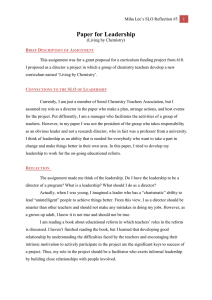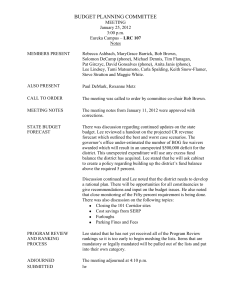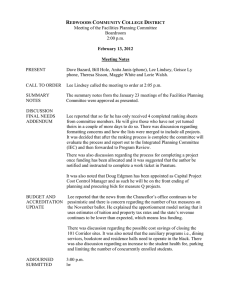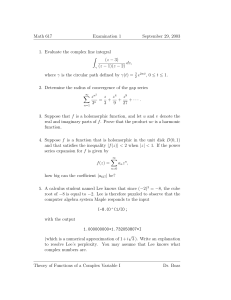My Work
advertisement
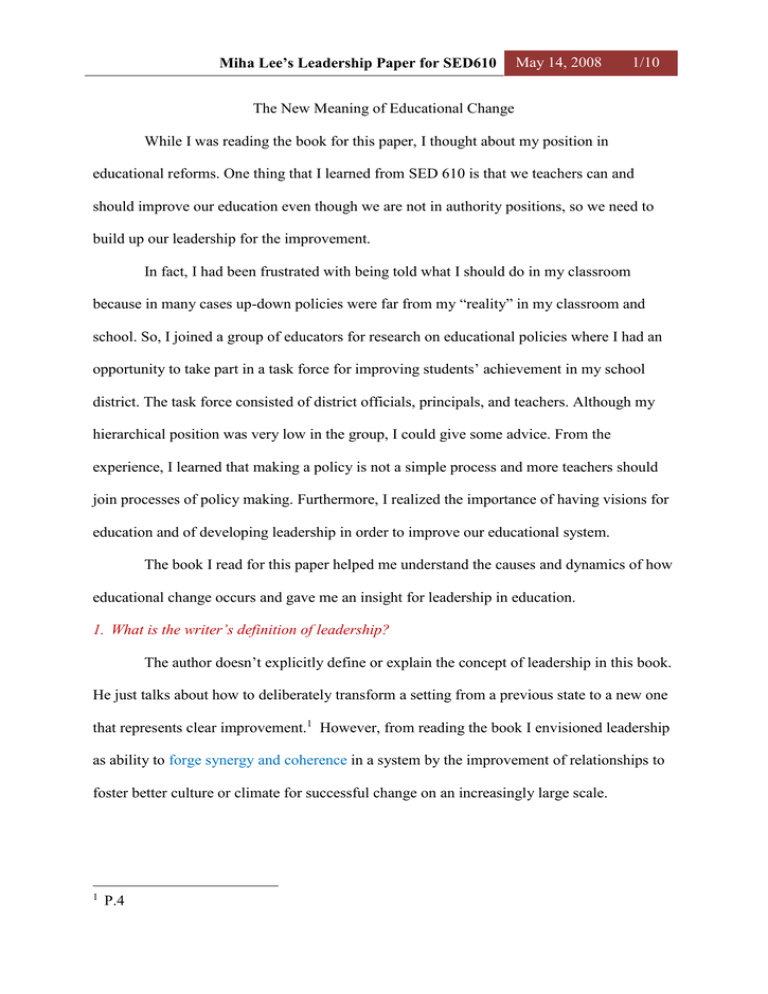
Miha Lee’s Leadership Paper for SED610 May 14, 2008 1/10 The New Meaning of Educational Change While I was reading the book for this paper, I thought about my position in educational reforms. One thing that I learned from SED 610 is that we teachers can and should improve our education even though we are not in authority positions, so we need to build up our leadership for the improvement. In fact, I had been frustrated with being told what I should do in my classroom because in many cases up-down policies were far from my “reality” in my classroom and school. So, I joined a group of educators for research on educational policies where I had an opportunity to take part in a task force for improving students’ achievement in my school district. The task force consisted of district officials, principals, and teachers. Although my hierarchical position was very low in the group, I could give some advice. From the experience, I learned that making a policy is not a simple process and more teachers should join processes of policy making. Furthermore, I realized the importance of having visions for education and of developing leadership in order to improve our educational system. The book I read for this paper helped me understand the causes and dynamics of how educational change occurs and gave me an insight for leadership in education. 1. What is the writer’s definition of leadership? The author doesn’t explicitly define or explain the concept of leadership in this book. He just talks about how to deliberately transform a setting from a previous state to a new one that represents clear improvement.1 However, from reading the book I envisioned leadership as ability to forge synergy and coherence in a system by the improvement of relationships to foster better culture or climate for successful change on an increasingly large scale. 1 P.4 Miha Lee’s Leadership Paper for SED610 May 14, 2008 2/10 Quality leadership is required to plan for, bring about, implement and accomplish innovations. Fullan suggests three sets of core practices of successful leaders in education.2 1. Setting directions: moral purposes, shared vision and group goals, high performance expectation 2. Developing people: individual support, intellectual/emotional stimulation, modeling 3. Redesigning the organization: collaborative cultures and structures, building productive relations with parents and community Making a difference in the lives of students requires leadership with care, commitment, and passion as well as the intellectual knowledge to do something about it.3 Leadership also includes cultivation of the next generation of leaders in the interests of continuity and deepening of good direction.4 2. How does this book relate to leadership in schools? This book is about how to combine “meaning” and “action” to achieve continuous improvement on a sustainable scale. Fullan focuses the book on such concepts as capacity building, learning in context, lateral capacity building, sustainability, and systems leaders in action. According to him, leaders at all levels should be engaged in changing the system, changing their own context. He also points out the importance of people who are morally and intellectually committed to educational improvement. The key to leading a successful change, which is to cope with endemic social complexity, is for individuals, especially in interaction with others, to arm themselves with knowledge of the change process, to engage in reflective action, and to test what they know against the increasingly available knowledge in the literature on change.5 2 3 4 5 P.166 P.20~21 P.59 P.xii~xiii Miha Lee’s Leadership Paper for SED610 May 14, 2008 3/10 The book is composed of three parts: Part I. Understanding Educational Change; Part II. Educational Change at the Local Level; and Part III. Educational change at the Regional and National Levels. Honestly, I didn’t finish all three parts, so I write the report based on the first two parts that I read. 3. How does it relate to management? According to Stacey (1996), while most leadership textbooks focus heavily on techniques and procedures for long-term planning, on the need for visions and missions, on the importance and the means of securing strongly shared cultures, on the equation of success with consensus, consistency, uniformity and order, the real management task is that of coping with and even using unpredictability, clashing counter-cultures, disensus, contention, conflict, and inconsistency. In short, the task that justifies the existence of all managers has to do with instability, irregularity, difference and disorder.6 Fullan also summarizes the role of management as providing continuing positive pressure and support.7 Effective management is required to alter the conditions for change in more favorable, workable directions8 and sustain the change. The solution to motivating people to work for change is to establish the right blend of tightness and looseness, or more accurately to build both into the interactive culture of the organization.9 In addition, people in managerial positions should ensure that the best people are working on the problem. In fact, the more talented teachers and principals are needed precisely because the challenges are greater. If the right combination of strategies and support 6 P.115 cited from Stacy, R. (1996). Strategic management and organizational dynamics (2nd ed.). London: Pitman. 7 P.9 8 P.118 9 P.43 Miha Lee’s Leadership Paper for SED610 May 14, 2008 4/10 is marshaled, problematic situations can become successful, and this could be where the best educators get their satisfaction.10 4. What does it mean to be a leader in a school? What it means to be a leader in a school is to build the school capacity to manage change. Because I perceive leadership as an ability to forge synergy and coherence in a system, I believe that capacity building is about what it takes to make friends and influence people to induce and carry out change. Solving complex educational problems as a leader on a continuous basis is enormously difficult because of the sheer number of factors at play. It is further complicated because the sine qua non of successful reform is whether relationships improve by collaboration and support. Indeed, a leader has to learn how to develop relationships with those s/he might not understand and might not like, and vice versa.11 Restoring people’s confidence in relationships requires four kinds of action: 1. Getting connected in new ways through conversation 2. Carrying out important work jointly 3. Communicating respect 4. Demonstrating inclusion Particularly, leaders should foster shared ownership and empowerment among teachers which eventually develop motivation to put energy into the reform direction12 by persistently working on multilevel meaning across the school over time.13 Any innovation cannot be assimilated unless its meaning is shared. The development of shared meaning of change results from the process of how those involved in change can come to understand what it is that should change, and how it can be best accomplished, while realizing that the 10 11 12 13 P.51 P.115 P.81~82 P.92 Miha Lee’s Leadership Paper for SED610 May 14, 2008 5/10 what and how constantly interact with and reshape each other. Educational change is a process of coming to grips with the multiple realities of people, who are the main participants in implementing change. Shared understanding among participants help them make a judgment whether they should accept, modify, or reject the change.14 However, prior to the development of shared meaning, individual must be able to attach personal meaning to change, regardless of how meaningful they might be to others. There is no reason for teachers to believe in the value of proposed changes, and few incentives to find out whether a given change will turn out to be worthwhile.15 All real change involves loss, anxiety, and struggle.16 Accordingly, the approach to change is important in developing the capacity to carry out change. Mutual adaptation or evolutionary perspective stresses that change often is and should be a result of adaptations and decisions made by users as they work with particular new policies or programs. The policy or program and the user’s situation mutually determine the outcomes.17 Therefore, leaders should help individuals find moral and intellectual meaning in new policies or programs to acquire their energy required to transform the status quo. Put differently, meaning fuels motivation to carry out the change.18 What motivates large number of people to invest their energies in making improvements and working collectively with others is to be driven by tapping into people’s dignity and respect. Leaders need to show empathy with people involved in difficult circumstances while calling for and reinforcing higher standards. If the policy makers or introducers ignore teachers’ anxiety and shrug off oppositions as ignorance or prejudice, they fail to develop shared meaning with teachers and thus fail to accomplish the change. For the reformers have already assimilated these changes to their purposes, and worked out a reformulation which makes 14 15 16 17 18 P.139 P.28 P.21 P.31 P.39 Miha Lee’s Leadership Paper for SED610 May 14, 2008 6/10 sense to them, perhaps through months or years of analysis and debate. If they deny others the chance to do the same, they express a profound contempt for them.19 Therefore, leaders should provide a framework of theory, values and related technology which enables individuals to make sense of their lives in change. Real change represents a serious personal and collective experience characterized by ambivalence and uncertainty; and if the change works out, it can result in a sense of mastery, accomplishment, and professional growth. The anxieties of uncertainty and the joys of mastery are central to the subjective meaning of educational change and to the success or failure thereof.20 In addition, capacity building is creating a highly motivating and energized collaborative culture in which people are passionate about their work and deeply focused on making and continuing changes that would get results. Capacity building creates work environments that is based on trust to make more comfortable exchanging ideas, and where a collective sense of responsibility for student development is likely to emerge. 21 Leaders should find ways of developing infrastructures and processes that engage teachers in developing new knowledge, skills and understandings required for roles associated with the new innovations to reduce the magnitude of resistance.22 Put differently, leaders should initiate ongoing professional development for the staff and engage themselves in it. Principals and teacher leaders actively foster collegial involvement, that is, collective commitment to student learning in collective settings.23 A leader in a school’s changing effort doesn’t need to be a principal, but in most case the principal is the person most likely to be in a position to shape the organizational conditions necessary for success, such as the development of shared goals, collaborative work 19 20 21 22 23 P.22 P.23 P.143 P.28~29 P.140 Miha Lee’s Leadership Paper for SED610 May 14, 2008 7/10 structures and climates, and procedures for monitoring results.24 Especially, the principal’s role is reconciling and combining top-down and bottom-up forces for change.25 Another work of leaders lies in the connection between their groups and the wider network that provides support, loyalty, revenues, or capital. Leaders must prove to those in the wider circle that their investments are warranted.26 5. What were the main lessons that you learned for your career from this book? The most important lesson to me from this book is the need for a professional learning community which is related to changing cultures of teacher society. Current school cultures are collegial loyalty, noninterference, and solidarity. Collegial loyalty serves to close down collective and reflective dialogue rather than embrace it. The “classroom press” isolates teachers from meaningful interaction with colleagues. Therefore, reculturing about how teachers come to question and change their beliefs and habits is what is needed. It is the leaders’ role that cultivates professional learning communities27 which foster an open exchange. Teachers in the communities deeply are engaged with other colleagues in joint planning, observation of one another’s practice, and seeking, testing, and revising teaching strategies on a continuous basis.28 Teachers need to work on practice-based inquiry and teaching for understanding, in which assessment, curriculum, and opportunities for teachers to learn about connecting assessment and instruction are evident on an ongoing basis. Teachers and teacher leaders should break down the autonomy of the classroom so that greater consistency of effective practice can be achieved. It is called lateral capacity building 24 25 26 27 28 P.96 P.11 P.62 P.48~49 P.7.54.55 Miha Lee’s Leadership Paper for SED610 through collaboration and support. 29 May 14, 2008 8/10 The crux of educational reform lies in the change of teachers’ culture from autonomy to interactions that stimulate continuous improvements.30 Significant educational change consists of changes in beliefs, teaching style, and materials, which can come about only through a process of personal development in a social context.31 Professional learning community is about the advantages of working with others, that is, peer relationship in a school. Educational change is a learning experience for the adults involved (teachers, administrators, parents, etc.) as well as for students. In a word, success of change depends on the degree and quality of change in actual practice.32 Professional learning community establishes a highly interactive infrastructure of pressure and support.33 New meanings, new behaviors, new skills, and new beliefs depend significantly on whether teachers are working as isolated individuals or are exchanging ideas, support, and positive feeling about their work with peers.34 According to Newmann and his colleagues, professional communities make the difference because: Teachers pursue a clear purpose for all students’ learning. Teachers engage in collaborative acitivty to achieve the purpose. Teachers take collaborative responsibility for student learning. Schoolwide teacher professional community affects the level of classroom authentic pedagogy, which in turn affects student perfprmance. Schoolwide teacher professional community affects the level of social support for student learninf, which in turn affects student performance.35 29 30 31 32 33 34 35 P.56 P.97,138 P.139 P.85 P.92 P.97 P.141~142 Miha Lee’s Leadership Paper for SED610 May 14, 2008 9/10 Two conditions for development of professional learning community are structural and social and human resources. Time to meet and talk, physical proximity, interdependent teaching roles, communication structures, and teacher empowerment and school autonomy are required for structural condition. Social and human resources include openness to improvement, trust and respect, cognitive and skill base, supportive leadership, and socialization. The structural conditions are easier to address than the cultural ones.36 Professional learning community can be developed not only within a school but also among schools via using media such as internet.37 Besides, there have been conflicts between administrators and teachers because each of them just think of things from their own view points. Policy makes charge that teachers are resistant to change; a teacher complains that administrators introduce change for their own self-aggrandizement and that they neither know what is needed not understand the classroom.38 However, Fullan explains that these conflicts prove the lack of relationships among people involved in change. Minds need to interact. As a teacher, sometimes we are forced to respond to and cope with educational change introduced by others. In this case, we should assume neither that it is beneficial nor it is useless. The major initial stance should involve critical assessment in which we should determine whether it is “implementable”. In other words, we should give heeds to decide whether it is worth the effort, because it will be an effort if it is worthwhile. A few things we need to consider to make the critical assessment are: Does the change address an unmet need? Is it a priority in relation to other unmet needs? Is it informed by some desirable sense of vision? Are there adequate resources such as technical assistance and leadership support committed to support implementation? If the conditions are reasonably favorable, we need to actively participate in the process of change. 36 37 38 P.149 P.152 P.3 Miha Lee’s Leadership Paper for SED610 May 14, 2008 10/10 If the conditions are not favorable or cannot be made favorable, the best coping strategy consists of knowing enough about the process of change so that we can understand why it doesn’t work, and therefore not blame ourselves. In sum, the problem is one of developing enough meaning about the change so that we are in a position to implement it effectively or reject it. 39 Bibliography Fullan, M. (2007). The New Meaning of Educational Change (4th ed.). Teachers College Press, Columbia University, New York 39 P.119~120
